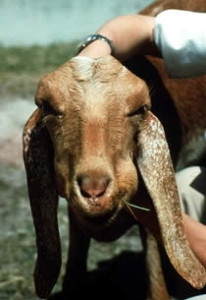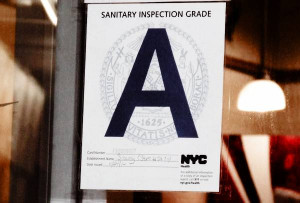I’m getting to old for this shit – cow shit, that is.
![HappyCow[1]](https://barfblog.com/wp-content/uploads/2014/08/HappyCow1-239x300.jpg) Lisa Egan writes in Nutritional Anarchy, whatever that is the commercial meat industry’s practice of keeping cattle in feedlots and feeding them grain that is responsible for the heightened prevalence of deadly E. coli O157:H7 bacteria. When cattle are grain-fed, their intestinal tracts become far more acidic, which favors the growth of pathogenic E. coli bacteria that can kill people who eat undercooked hamburger.
Lisa Egan writes in Nutritional Anarchy, whatever that is the commercial meat industry’s practice of keeping cattle in feedlots and feeding them grain that is responsible for the heightened prevalence of deadly E. coli O157:H7 bacteria. When cattle are grain-fed, their intestinal tracts become far more acidic, which favors the growth of pathogenic E. coli bacteria that can kill people who eat undercooked hamburger.
The author cites a 1998 study that has been completely discredited.
Since September 1998, there has been conflicting information on the effect of diet on E. coli shedding from cattle. The conflict arises in part from the effect of diet on the ability of E. coli to develop acid resistance. … Diez-Gonzalez et. al demonstrated that feeding a high-grain diet to cattle results in an acidic environment in the colon. Because the animals incompletely digested the starch in grains, some starch was able to reach the colon where it fermented, producing fermentation acids. The researchers believe an acidic environment selects for or induces acid resistance among the Escherichia coli population. … Diez-Gonzalez et al. concluded that if cattle were given hay for a brief period (five days) immediately before slaughter, the risk of foodborne E. coli infection would be significantly reduced because the acidity in the colon is greatly reduced. “Our studies indicate that cattle could be given hay for a brief period immediately before slaughter to significantly reduce the risk of food-borne E. coli infection.”
The Science article received mainstream media attention, and was covered by the Associated Press and The New York Times, as well as scientific releases and reports. In the Irish Times, it was cited as the basis for concluding that because Irish cattle are fed a grass-based diet rather than grain, Ireland has a low incidence of E. coli O157:H7. Hancock et al. contend that this conclusion is unsupported or contradicted by several lines of evidence. The E. coli that contaminate beef typically originate from the hide, the hooves, or the equipment used in slaughter and processing rather than directly from the colon, and likely replicate in environments unlike the colon. Therefore, the induced acid resistance of E. coli contaminating beef is likely to be unrelated to the pH of its ancestral colonic environment. The E. coli O157:H7 bacterium uses several mechanisms to survive acid environments, some of which are innate and are not influenced by environment . Although acid resistance is likely a factor in an infective dose, induced acid resistance has not been shown to be a factor in E. coli O157:H7 infectivity by experimental (dose-inoculation) or observational (epidemiological) data . Therefore, acid resistance induced by exposure to weak acid may not influence the virulence of this pathogen.
Published data on E. coli O157:H7 tends to contradict or does not support the effects of the dietary change proposed by Diez-Gonzalez et al. In a recent study on three different grain diets (85% cracked corn, 15% whole cottonseed and 70% barley, or 85% barley), the fecal pH of the animals fed the corn diet was significantly lower (P < 0.05) than the fecal pH of the animals fed the cottonseed and barley and barley diets, likely resulting in a less suitable environment for E. coli O157:H7 in the hindgut of the corn fed animals (2000, Buchko et al). In the Journal of Food Protection, researchers concluded that changing from grain to a high roughage diet did not produce a change in the E. coli concentration that was large enough to deliver a drastic improvement in beef carcass hygiene. Sheep experiencing an abrupt diet change have higher concentrations and increased shedding of fecal E. coli O157:H7 for longer periods than sheep fed a consistent high-grain diet. Another study compared the duration of shedding E. coli O157:H7 isolates by hay-fed and grain-fed steers experimentally inoculated with E. coli O157:H7 as well as the acid resistance of the bacteria. The hay-fed animals shed E. coli O157:H7 longer than the grain-fed animals, and irrespective of diet, these bacteria were equally acid resistant.
 These results suggest that the proposed dietary change would actually increase contamination with E. coli O157:H7. Also, the 1,000-fold reductions in total fecal E. coli demonstrated by Diez-Gonzales et al. are far greater than those recorded in cattle experiencing similar ration changes . Finally, extensive surveys show that grain-fed feedlot cattle have no higher E. coli O157:H7 infection prevalence than similarly aged dairy cattle fed forage (hay) diets. Abrupt feed change immediately before slaughter could have unexpected deleterious effects. The proposed diet change has the potential to increase the risk of bovine salmonella infections, a potential source of food poisoning. The dietary change results in sharply reduced volatile fatty acid concentrations in the large intestine as well as changes in the bacteria, allowing for colonization of Salmonella.
These results suggest that the proposed dietary change would actually increase contamination with E. coli O157:H7. Also, the 1,000-fold reductions in total fecal E. coli demonstrated by Diez-Gonzales et al. are far greater than those recorded in cattle experiencing similar ration changes . Finally, extensive surveys show that grain-fed feedlot cattle have no higher E. coli O157:H7 infection prevalence than similarly aged dairy cattle fed forage (hay) diets. Abrupt feed change immediately before slaughter could have unexpected deleterious effects. The proposed diet change has the potential to increase the risk of bovine salmonella infections, a potential source of food poisoning. The dietary change results in sharply reduced volatile fatty acid concentrations in the large intestine as well as changes in the bacteria, allowing for colonization of Salmonella.
Mike Osterholm, director of the Center for Infectious Disease Research and Policy and professor in the School of Public Health at the University of Minnesota wrote a cleaner critique in 2007 in the Minneapolis-St. Paul Star Tribune:
“Russo cited conclusions from a 1998 study from Cornell University that cattle fed a diet of grass, not grain, had very few E. coli, and that those bacteria that survived in the cattle feces would not survive in the human when eaten in undercooked meat, particularly hamburger. This statement is based on a study of only three cows rotated on different diets and for which the researchers did not even test for E. coli O157:H7. Unfortunately, the authors extrapolated these incredibly sparse results to the entire cattle industry. The Cornell study is uncorroborated in numerous published scientific papers from renowned research groups around the world. Finally, work conducted by the Minnesota Department of Health as part of a national study on foodborne disease recently showed that eating red meat from local farms was a significant risk factor for E. coli infection. …
And as my colleague David Renter wrote in Sept. 2006,
“Cattle raised on diets of ‘grass, hay and other fibrous forage’ do contain E. coli O157:H7 bacteria in their feces as do other animals including deer, sheep, goats, bison, opossum, raccoons, birds, and many others.
“Cattle diet can affect levels of E. coli O157:H7, but this is a complex issue that has been and continues to be studied by many scientists. To suggest switching cattle from grain to forage based on a small piece of the scientific evidence is inappropriate and irresponsible. Several pieces of evidence suggest that such a change would not eliminate and may even increase E. coli O157:H7 in cattle.
“The current spinach outbreak may be traced back to cattle manure, but there are many other potential sources. Simplistically attacking one facet of livestock production may be politically expedient, but instead provides a false sense of security and ignores the biological realities of E. coli O157:H7. In 1999, for example, 90 children were felled by E. coli O157:H7 at a fair in London, Ont. The source? A goat at a petting zoo, hardly an intensively farmed animal.”
Last time I looked, E. coli O157:H7 and about 60 other shiga-producing E. coli that are known to cause illness in humans are present in about 10 per cent of all ruminants – cattle, sheep, goats, deer, elk -– and I can point to outbreaks associated with all of those species. Pigs, chickens, humans, birds and rodents have all been shown to be carriers of shiga-producing E. coli but the resevoir appears to be ruminants.
That Cornell paper can be found here:
Diez-Gonzalez, Francisco, Todd R. Callaway, Menas G. Kizoulis, James B. Russell. Grain Feeding and the Dissemination of Acid-Resistance Escherichia coli from Cattle. Science: Sept 11, 1998. Volume 281, Number 5383, pages 1666-1668.
 Four pathogens cause about 90% of the 1.6 million illnesses caused by known pathogens: Norovirus (1 million cases), Clostridium perfringens (177,000 cases), Campylobacter (145,000 cases) and nontyphoidal Salmonella (88,000 cases). These estimates are based on multiple complementary disease surveillance systems and the peer-reviewed literature.
Four pathogens cause about 90% of the 1.6 million illnesses caused by known pathogens: Norovirus (1 million cases), Clostridium perfringens (177,000 cases), Campylobacter (145,000 cases) and nontyphoidal Salmonella (88,000 cases). These estimates are based on multiple complementary disease surveillance systems and the peer-reviewed literature.






![HappyCow[1]](https://barfblog.com/wp-content/uploads/2014/08/HappyCow1-239x300.jpg)



